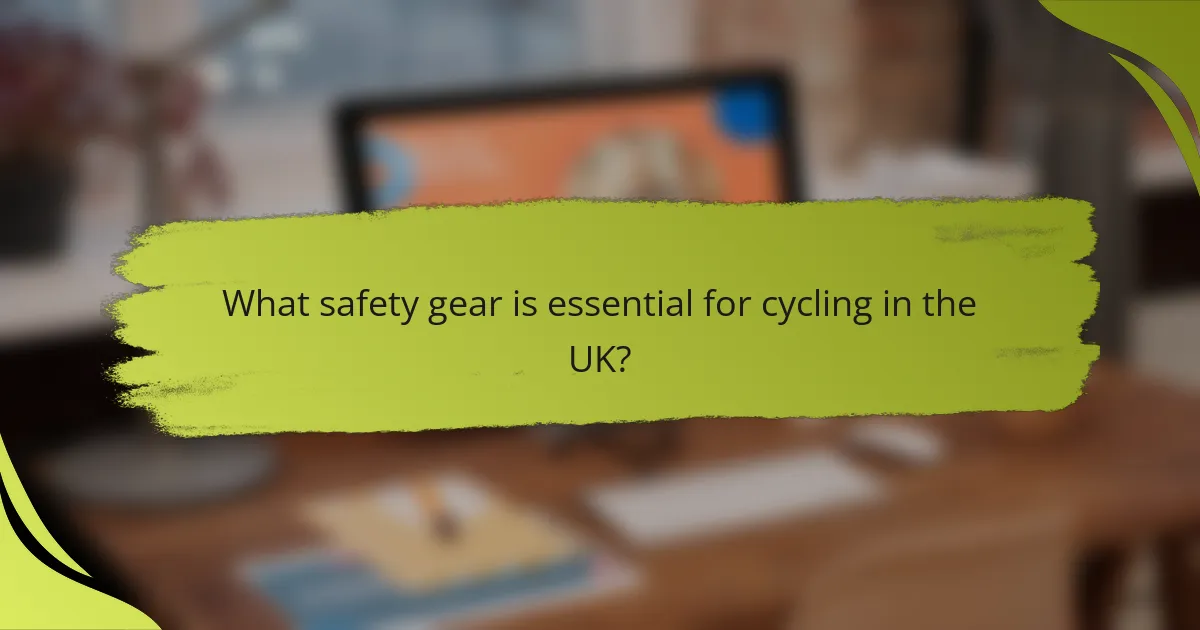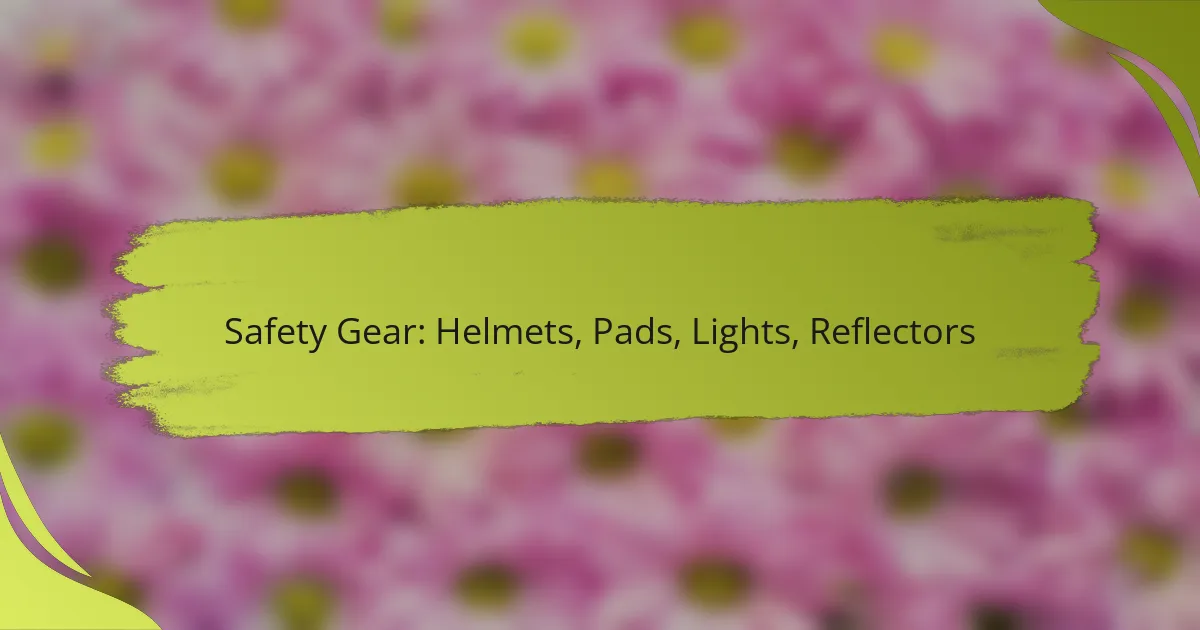Safety gear is crucial for cyclists, particularly in the UK, where helmets, knee and elbow pads, lights, and reflectors play a vital role in protecting riders and enhancing visibility. A properly fitted helmet can greatly reduce the risk of head injuries, while quality pads ensure protection during falls. Additionally, lights and reflectors are essential for being seen on the road, especially in low-light conditions.

What safety gear is essential for cycling in the UK?
Essential safety gear for cycling in the UK includes helmets, knee and elbow pads, lights, and reflectors. These items significantly enhance safety by protecting the cyclist from injuries and increasing visibility on the road.
Helmets for head protection
Helmets are crucial for protecting your head in case of falls or collisions. In the UK, it’s recommended to choose a helmet that meets the British Standard (BS EN 1078) for optimal safety. Look for a snug fit with adjustable straps to ensure it stays securely in place.
When selecting a helmet, consider factors like weight, ventilation, and style. A lightweight helmet with good airflow can enhance comfort during longer rides. Regularly inspect your helmet for any signs of damage and replace it every few years or after a significant impact.
Knee and elbow pads for joint safety
Knee and elbow pads provide essential protection for your joints while cycling, especially during falls. These pads absorb impact and reduce the risk of serious injuries. Look for pads that are comfortable, breathable, and fit securely to avoid slipping during rides.
Consider using pads that comply with safety standards, such as the EN 14120 for knee protection. It’s advisable to wear these pads, particularly for beginners or when riding in areas with high traffic or rough terrain.
Lights for visibility
Lights are vital for ensuring visibility during low-light conditions or at night. In the UK, cyclists are required by law to have a white front light and a red rear light when riding after dark. Opt for LED lights, as they are bright, energy-efficient, and often rechargeable.
When choosing lights, consider brightness measured in lumens; a minimum of 200 lumens for the front light is recommended for urban cycling. Additionally, select lights with multiple flashing modes to increase visibility to other road users.
Reflectors for increased safety
Reflectors enhance your visibility to others on the road, particularly in low-light situations. In the UK, bicycles must have reflectors on the front, rear, and pedals. Ensure that these reflectors are clean and unobstructed to maximize their effectiveness.
Consider adding additional reflective gear, such as vests or stickers, to your cycling outfit. This can significantly improve your visibility, especially in poorly lit areas or during inclement weather conditions.

How to choose the right helmet?
Choosing the right helmet involves assessing fit, safety certifications, and comfort features. A well-fitted helmet can significantly reduce the risk of head injuries while providing comfort during use.
Fit and comfort considerations
When selecting a helmet, ensure it fits snugly without being overly tight. It should sit level on your head, with the front edge just above your eyebrows. Many helmets come with adjustable straps and padding to enhance comfort and fit.
Consider the shape of your head as well; some helmets are designed for round heads, while others cater to oval shapes. Trying on different models can help you find the best fit for your specific head shape.
Safety certifications to look for
Look for helmets that meet recognized safety standards such as CPSC in the United States or EN 1078 in Europe. These certifications indicate that the helmet has undergone rigorous testing for impact resistance and durability.
Additionally, some helmets may carry certifications from organizations like Snell or ASTM, which can provide extra assurance of safety. Always check for labels that confirm compliance with these standards before making a purchase.
Weight and ventilation features
Helmet weight can affect comfort, especially during long rides. Lightweight helmets, typically weighing between 200 to 400 grams, are easier to wear for extended periods. However, ensure that lightweight options do not compromise safety.
Ventilation is also crucial for comfort. Look for helmets with multiple vents that promote airflow, helping to keep your head cool. A well-ventilated helmet can make a significant difference during hot weather or strenuous activities.

What are the best knee and elbow pads available?
The best knee and elbow pads provide essential protection for cyclists and skaters, combining comfort, durability, and safety features. Look for pads that meet safety standards and fit well to ensure maximum protection during activities.
Top brands for knee pads
Leading brands for knee pads include Fox Racing, 661, and G-Form. These companies are known for their high-quality materials and innovative designs that enhance mobility while providing robust protection.
When selecting knee pads, consider factors such as the level of padding, breathability, and adjustability. For example, G-Form offers pads that are lightweight and flexible, making them ideal for long rides, while Fox Racing provides options with more rigid protection for downhill biking.
Recommended elbow pads for cyclists
For cyclists, recommended elbow pads include those from brands like POC, Race Face, and Alpinestars. These pads are designed to absorb impact and prevent injuries during falls or collisions.
When choosing elbow pads, prioritize fit and comfort. Look for adjustable straps and breathable materials to ensure they stay in place without causing discomfort. POC’s elbow pads, for instance, are known for their ergonomic design, which allows for a full range of motion while riding.

How do bike lights enhance safety?
Bike lights enhance safety by increasing visibility for both cyclists and motorists, especially in low-light conditions. They help prevent accidents by making riders more noticeable to others on the road.
Types of bike lights
There are several types of bike lights, including front lights, rear lights, and reflective lights. Front lights illuminate the path ahead, while rear lights signal the cyclist’s presence to vehicles approaching from behind. Reflective lights, often attached to helmets or clothing, enhance visibility without requiring a power source.
Bike lights can be categorized into two main types: steady and flashing. Steady lights provide constant illumination, which is useful for clear visibility, while flashing lights can attract more attention, making them effective in alerting drivers.
Brightness levels and visibility range
Brightness levels for bike lights are typically measured in lumens, with most effective lights ranging from around 100 to 1000 lumens. A light with 200-400 lumens is generally sufficient for urban riding, while off-road or high-speed cycling may require brighter options.
The visibility range of bike lights can vary significantly; a good front light should illuminate the road for at least 50-100 meters, while rear lights should be visible from a distance of at least 200 meters. When choosing lights, consider the environment and typical riding conditions to ensure optimal safety.

What are the legal requirements for reflectors in the UK?
In the UK, reflectors are required for certain vehicles to enhance visibility during low-light conditions. The specific regulations dictate the types and placements of reflectors to ensure safety on the roads.
Mandatory reflector types
The UK law mandates that bicycles must have at least one red reflector on the rear and white reflectors on the front. Additionally, pedal reflectors are required, which can be either white or amber, depending on the design. Motor vehicles must also comply with reflector requirements, including red reflectors on the rear and amber ones on the sides.
Placement guidelines for reflectors
Reflectors must be positioned to maximize visibility; for bicycles, the front reflector should be mounted at least 35 cm above the ground, while the rear reflector should be no higher than 1.5 meters. For motor vehicles, reflectors should be placed in a way that they are easily seen by other road users, typically at the rear and sides. Regular checks are advisable to ensure reflectors are clean and unobstructed for optimal effectiveness.

What are the benefits of using high-visibility gear?
High-visibility gear enhances safety by making individuals more noticeable to others, especially in low-light or nighttime conditions. This increased visibility can significantly reduce the risk of accidents and injuries.
Increased safety during night rides
Wearing high-visibility gear during night rides is crucial for safety. Bright colors and reflective materials help ensure that cyclists, pedestrians, and motor vehicle drivers can see you from a distance. For instance, a reflective vest or jacket can make a rider visible from hundreds of meters away, which is vital when navigating poorly lit areas.
When choosing gear for night riding, consider options that combine both bright colors and reflective elements. This dual approach maximizes visibility and provides an extra layer of safety.
Improved visibility in low-light conditions
High-visibility gear is essential in low-light conditions such as dawn, dusk, or overcast weather. Items like fluorescent helmets, arm bands, and leg straps can significantly enhance your visibility to others. These items should be worn in conjunction with lights to ensure comprehensive safety.
To maximize visibility, opt for gear that meets safety standards, such as those set by the American National Standards Institute (ANSI) or similar organizations in your country. Regularly inspect your gear for wear and tear to maintain its effectiveness.

How to maintain your safety gear?
Maintaining your safety gear is crucial for ensuring its effectiveness and longevity. Regular inspections and proper cleaning can prevent accidents and enhance performance.
Helmets
To maintain your helmet, inspect it regularly for cracks or dents that could compromise its safety. Clean the outer shell with mild soap and water, avoiding harsh chemicals that can degrade materials.
Replace your helmet every few years or after any significant impact, as its protective capabilities may diminish over time. Ensure that the fit remains snug and comfortable, adjusting the straps as necessary.
Pads
Safety pads should be checked for wear and tear, particularly at the seams and padding. Wash them according to the manufacturer’s instructions, typically using cold water and air drying to preserve their shape and integrity.
Consider replacing pads if they show signs of excessive wear or if they no longer fit properly. Properly fitted pads provide better protection and comfort during use.
Lights
For lights, regularly check the batteries and replace them as needed to ensure visibility. Clean the lens to remove dirt and grime that can reduce brightness.
Consider using rechargeable lights for convenience and sustainability. Always test your lights before heading out, especially in low-light conditions.
Reflectors
Inspect reflectors for any damage or discoloration that may affect their visibility. Clean them with a soft cloth to maintain their reflective properties.
Replace any reflectors that are cracked or have lost their reflective quality. Properly placed reflectors can significantly enhance your visibility to others, especially at night.
